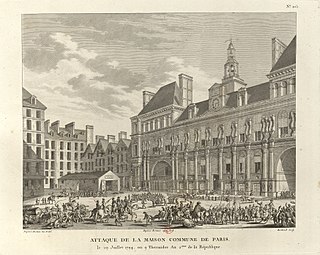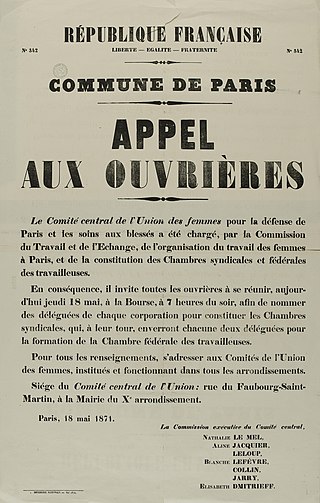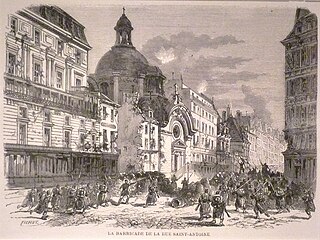
Montmartre is a large hill in Paris's northern 18th arrondissement. It is 130 m (430 ft) high and gives its name to the surrounding district, part of the Right Bank. Montmartre is primarily known for its artistic history, for the white-domed Basilica of the Sacré-Cœur on its summit, and as a nightclub district.

Pigalle is an area in Paris, France, around the Place Pigalle, on the border between the 9th and the 18th arrondissements. It is named after the sculptor Jean-Baptiste Pigalle (1714–1785).

The Paris Commune during the French Revolution was the government of Paris from 1789 until 1795. Established in the Hôtel de Ville just after the storming of the Bastille, it consisted of 144 delegates elected by the 60 divisions of the city. Before its formal establishment, there had been much popular discontent on the streets of Paris over who represented the true Commune, and who had the right to rule the Parisian people. The first mayor was Jean Sylvain Bailly, a relatively moderate Feuillant who supported constitutional monarchy. He was succeeded in November 1791 by Pétion de Villeneuve after Bailly's unpopular use of the National Guard to disperse a riotous assembly in the Champ de Mars.

The September Massacres were a series of killings and summary executions of prisoners in Paris that occurred in 1792, from Sunday, 2 September until Thursday, 6 September, during the French Revolution. Between 1,176 and 1,614 people were killed by sans-culottes, fédérés, and guardsmen, with the support of gendarmes responsible for guarding the tribunals and prisons, the Cordeliers, the Committee of Surveillance of the Commune, and the revolutionary sections of Paris.

The Tuileries Palace was a royal and imperial palace in Paris which stood on the right bank of the River Seine, directly in front of the Louvre. It was the usual Parisian residence of most French monarchs, from Henry IV to Napoleon III, until it was burned by the Paris Commune in 1871.

Passy is an area of Paris, France, located in the 16th arrondissement, on the Right Bank. It is adjacent to Auteuil to the southwest, and Chaillot to the northeast.

The insurrection of 10 August 1792 was a defining event of the French Revolution, when armed revolutionaries in Paris, increasingly in conflict with the French monarchy, stormed the Tuileries Palace. The conflict led France to abolish the monarchy and establish a republic.

Henri Lefebvre was a French Marxist philosopher and sociologist, best known for pioneering the critique of everyday life, for introducing the concepts of the right to the city and the production of social space, and for his work on dialectical materialism, alienation, and criticism of Stalinism, existentialism, and structuralism. In his prolific career, Lefebvre wrote more than sixty books and three hundred articles. He founded or took part in the founding of several intellectual and academic journals such as Philosophies, La Revue Marxiste, Arguments, Socialisme ou Barbarie, and Espaces et Sociétés.

The Women's March on Versailles, also known as the October March, the October Days or simply the March on Versailles, was one of the earliest and most significant events of the French Revolution. The march began among women in the marketplaces of Paris who, on the morning of 5 October 1789, were nearly rioting over the high price of bread. The unrest quickly became intertwined with the activities of revolutionaries seeking liberal political reforms and a constitutional monarchy for France. The market women and their allies ultimately grew into a crowd of thousands. Encouraged by revolutionary agitators, they ransacked the city armory for weapons and marched on the Palace of Versailles. The crowd besieged the palace and, in a dramatic and violent confrontation, they successfully pressed their demands upon King Louis XVI. The next day, the crowd forced the king and his family to return with them to Paris. Over the next few weeks most of the French Assembly also relocated to the capital.

Nathalie Lemel, was a militant anarchist and feminist who participated on the barricades at the Commune de Paris of 1871. She was deported to Nouvelle Calédonie with Louise Michel.

The Musée de Montmartre is located in Montmartre, at 8-14 rue Cortot in the 18th (XVIII) arrondissement of Paris, France. It was founded in 1960 and was classified as a Musée de France in 2003. The buildings were formerly the home of several famous artists, including Pierre-Auguste Renoir and Suzanne Valadon.

The Boulevard de Clichy is a famous street of Paris, which lends its name to the Place de Clichy, resulted from the fusion, in 1864, of the roads that paralleled the Wall of the Farmers-General, both inside and out. It extends from the Place de Clichy to the Rue des Martyrs, nearly a kilometre away. During its tenure, the street has been known as the Boulevard des Martyrs, then the Boulevard Pigalle, and, finally, the Boulevard de Clichy. It is equally well known as the Boulevard Clichy.

Christer Strömholm, also known by the pseudonym Christer Christian, was a Swedish photographer and educator. He is known for his intimate black and white street photography portrait series, particularly his portraits of transgender women in Paris. Strömholm received the 1997 Hasselblad Award.

Union des femmes pour la défense de Paris et les soins aux blessés was a women's group during the 1871 Paris Commune. The union organized working women, ensured a market and fair pay for their work, and participated in the defence of Paris against the troops of the Third Republic, particularly at Place Blanche.

The semaine sanglante was a weeklong battle in Paris from 21 to 28 May 1871, during which the French Army recaptured the city from the Paris Commune. This was the final battle of the Paris Commune.

Blanche Lefebvre was a communard active in the Batignolles quarter in the 17th arrondissement of Paris. She died defending the Paris Commune during "bloody week".
Béatrix Excoffon, born Julia Euvrie or Œuvrie was a militant communard who served as an ambulance nurse during the Paris Commune in 1871. She was vice-president of the Club des Femmes de la Boule Noire, and was known as "the republican".
The Paris Commune was an insurrectionary period in the history of Paris that lasted just over two months, from 18 March 1871 to the Semaine sanglante that ended on 28 May 1871. This insurrection refused to recognize the government of the National Assembly of 1871, which had just been elected by universal male suffrage. Many women took active roles in the events, and are known as "communardes". They are important in the history of women's rights in France, particularly with regards to women's emancipation. Equal pay and the first forms of structured organization of women in France appear during this period, in particular the Union des femmes pour la défense de Paris et les soins aux blessés or the Comité de vigilance de Montmartre.

Chez Moune is a Parisian nightclub that originally opened as Le Fetiche in 1936 in the Place Pigalle. It has been described as the first lesbian club with dancing and cabaret in Europe. Since the late 1980s, it has been a nightclub for mixed clientele.

Le Rat Mort was a popular cafe/restaurant and cabaret in Paris in the 19th and early 20th centuries. Located in the Place Pigalle in the Montmartre District, it was frequented by artists, writers, actors, artist models, and prostitutes, and was a gathering place for lesbians in the evenings. Paintings and sketches inspired by the cafe and its customers included work by Toulouse Lautrec, Maxime Dethomas, Auguste Chabaud and Maurice de Vlaminck.

















